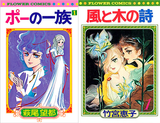>Question 5: Mr. Torishima, we recently discovered the manga The Poe Clan and Kaze to Ki no Uta. You said those were the first manga you found interesting. Could you tell us what you found intriguing about those titles?
>Torishima: I had never read manga in my life, and when I joined Shueisha, they told me to look at old issues of Shonen Jump. I read tons of them and they were all terrible. My superior asked me to rank the manga from 1 to 10 and give my comments, then to read the readers’ weekly survey results. And that was a shock. The readers’ rankings were the complete opposite of mine. I seriously considered quitting the company and looking at job offers elsewhere.
>Next to the Shueisha building, there was an archive building, and since I was bored in the editorial office, I would go there to take naps. I realized that since it was an archive, it was full of manga, so I decided to read everything. The first manga I found interesting was a shojo. I don’t know if you know this, but there’s a group called the “Year 24 Group” (i.e., mangaka who began their careers around 1969), and that year saw the emergence of a new tone in manga, often more adult and subversive.
>Keiko Takemiya (Kaze to Ki no Uta), who came up during that time. There were works by Keiko Takemiya and others that tackled themes never seen in manga back then, like the feeling of romantic love between children, etc. I was very impressed to see these deeply humanistic themes. This was over 50 years ago, and it was truly surprising back then. The problem is that in Shonen Jump, even now, there are manga that feel horribly outdated.
>But thanks to that experience of reading through the archives, I discovered that interesting manga existed, and most importantly, that some creators had the tools to make them. And it was while searching for someone capable of making truly interesting manga that I met Akira Toriyama. These are the authors who gave me the clues on how to make manga evolve.
